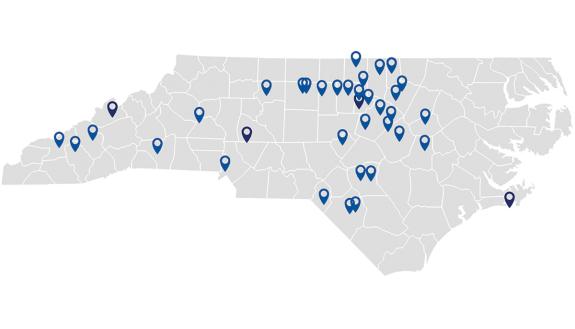The Impact Of Duke Across North Carolina
Annual report shows the engagement that comes from Duke’s role as a top employer, economic driver, research institution, health care provider and leader in education

Employment and Economic Impact: Duke is the second largest private employer in North Carolina with more than 44,500 full-time and part-time employees in the state. Duke’s employee health insurance provides benefits for more than 75,500 residents. Duke fuels the economy locally and statewide through campus and clinical operations, purchasing goods and services, and leasing building space.
Higher Education and Research: More than 16,800 students are enrolled at the university, with more undergraduate students coming from North Carolina than from any other state. Duke is committed to expanding access to education for students from the Carolinas and announced in 2023 that it will provide full tuition grants to students from low-income families. Duke has provided more than $25 million to undergraduate students from North Carolina this academic year.
Duke’s research mission also is a driver of the state’s economy. In FY2022, Duke surpassed $1.39 billion in research expenditures. Some of that research is translated into new business ventures. Of the 15 new startup companies formed last fiscal year, 66% are headquartered in the state.
Explore Duke in North Carolina

An interactive map provides data, including students, alumni and patients, residing in each of North Carolina’s 100 counties.
Health Care: Duke University Health System (DUHS) serves patients in all 100 North Carolina counties with more than 400 clinics and care locations. Duke provided $1.088 billion in community benefit and investment in FY23. In addition to its three hospitals, Duke has an extensive network of outpatient facilities across the state. Duke Primary Care is the largest primary care network in the greater Triangle area with nearly 50 locations throughout the region. Duke Health Integrated Practice (DHIP) operates more than 110 primary and specialty care clinics in central and eastern North Carolina.
More than 8,300 Duke-trained health care professionals live and work in North Carolina, and Duke educates hundreds of new health care professionals each year. DUHS also reaches many rural parts of the state through its joint venture with Lifepoint Health. Duke LifePoint operates nine hospitals ranging from the mountains to the eastern part of the state.
Purposeful Partnerships: Duke is committed to prioritizing the needs of our neighbors and improving the quality of life in our region. Duke Community Affairs guides engagement efforts in Durham across five community-driven focus areas, including housing, health, education, employment and community.
Purposeful partnerships are forged in Durham and beyond, from innovative research and K-12 collaborations at the Marine Lab in Beaufort to the groundbreaking community-engaged population health initiatives at Duke Kannapolis to Divinity School programs to help rural communities and churches thrive.
Regional Attractions: Duke Chapel, Duke Gardens and the Duke Forest are major attractions in the region. Duke Forest spans three counties in the north-central Piedmont region of North Carolina. Duke Arts builds meaningful connections between campus and community audiences through free arts workshops and public arts events. The Nasher Museum of Art at Duke is a major center for the arts, with more than 1 million visitors since it opened in 2005.